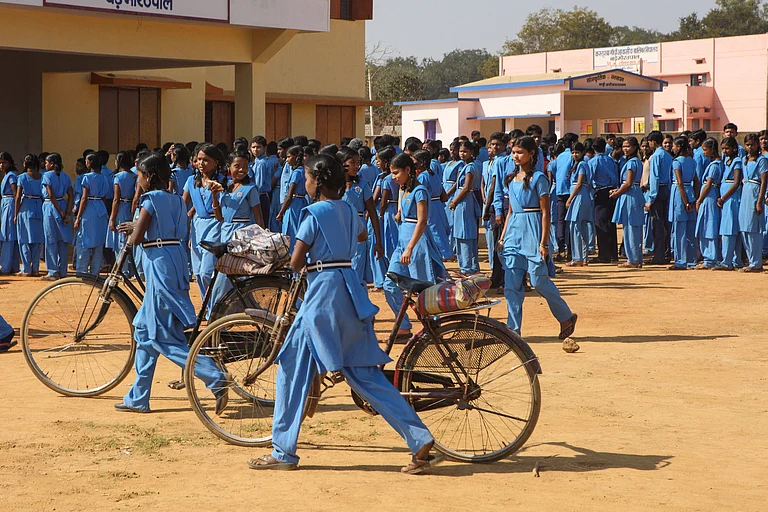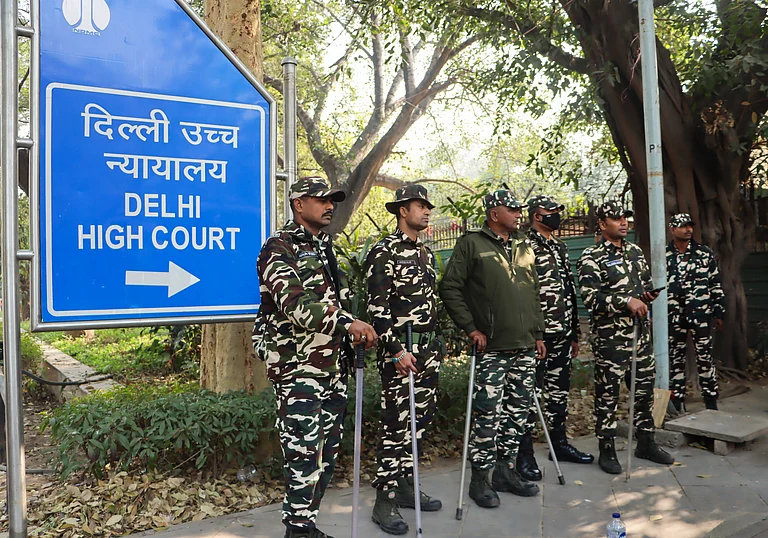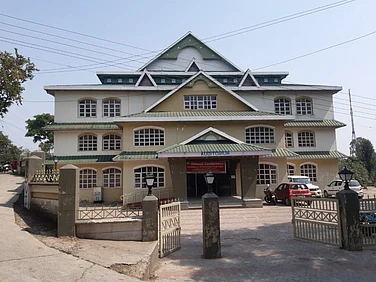A fresh blanket of snow drapes Zoji La, a mountain pass that serves as the bridge between the Kashmir Valley and Ladakh, around 102 km north of Srinagar. This uninhabited expanse—which marks the end of the conifer-clad mountains and is an entry point to Ladakh—is normally shrouded in silence. These days, however, the persistent hum of mighty excavators and American augur machines reverberates across the mountains. A team of workers and engineers are working very hard to carve a tunnel through the formidable terrain.
A 2.5-hour-long drive from Srinagar takes one to the 11,575-foot pass that separates the Union Territories of Jammu and Kashmir and Ladakh. The Sindh River flows to the East of the road. Beyond the river are the breathtakingly beautiful villages with homes having coloured tin roofs that are in vogue in the Kashmir Valley these days. The villages are surrounded by pine trees. Along the road, one comes across a few island villages surrounded by the Sindh River. On the left, excavation work is underway high in the mountains to construct new roads leading to Sonamarg. A trip to the popular tourist destination exemplifies the ongoing developmental projects in the area.
As dawn breaks, Zoji La comes alive with the clanking of machines breaking the stillness that once prevailed. Young engineers, mostly locals, are led and guided by seasoned counterparts from different states and experts from Austria. They are seen navigating through the challenging landscape; their helmets and safety gear gleaming against the snow-covered backdrop.
Extensive infrastructure development projects have been set in motion across Jammu and Kashmir, and Ladakh, and a network of tunnels, bridges and roads is coming up. For rapid mobilisation of troops in the hostile high-altitude Ladakh, where temperatures go down to minus 45 degrees, the Border Roads Organisation (BRO) is building 255 km of strategic roads in Ladakh.
Among these planned roads is the 78-km stretch from Khalsa to the Batalik sector, the 70-km road from Khalsar through Agham village to Shyok, the river that flows down from the Galwan Valley to Nubra, and the 31-km road from Tangste to Lukung. Even the 26-km Hanuthang-Handanbroke-Zungpal-Turtuk road, which bypasses the Khardungla Pass, is almost complete. It will bring down the Leh-Turtuk travel time from nine hours to three hours.
The Zoji La Tunnel project is a part of the government’s initiative to construct around 41 significant tunnels in Jammu and Kashmir, as well as Ladakh. It stands as a crucial link and is set to grant year-round access to Ladakh. Strategically, it holds immense importance, allowing troop movement throughout the year. The tunnel at the highest altitude will significantly reduce the time to cross the Zoji La Pass from four hours to just 15 minutes.
The project was first conceived in 2005 but the actual work started in October 2020 which was undertaken by Megha Engineering and Infrastructure at an estimated cost of Rs 4,600 crore. Earlier, the deadline to complete the project was set as December 2026, but now it has been extended to December 2028.
Earlier this year, after inspecting Z-Morh and Zoji La tunnels, Nitin Gadkari, the Union Minister for Road Transport and Highways, while giving a sense of the infrastructure work in the region, revealed that the ministry has taken up projects worth Rs 1,25,000 crore in Jammu and Kashmir. He said around 500 km of the planned road network has been completed in the region, and about 1,700 km of roads are being constructed at the cost of Rs 75,000 crore.
Gadkari announced the tunnels and two lanes for the Mughal road. The 84-km long road links Kashmir Valley with the Poonch district of Jammu and has provided an alternative link road to the Valley since it was opened for traffic in 2010. The tunnels will make it all-weather. The road passes over the Pir Panjal mountain range, at an altitude of 11,500 ft, which is higher than the Banihal pass.
While some experts believe such widespread construction should not happen in the sensitive Himalayan region, others feel these infrastructural projects are a necessity and there is no alternative to building underground tunnels in the Himalayas.
In her book, White as the Shroud: India, Pakistan and the War on the Frontiers in Kashmir, journalist Myra MacDonald described the situation along the LAC in Ladakh as ‘India-China’s infrastructure arms race’. “First China, then India, built roads and other infrastructure to help them move troops quickly to the frontier,” the book mentions.
However, for Pankaj Srivastava, who works at the Department of Geology, University of Jammu, tunnelling in the Himalayas, including Jammu and Kashmir, is necessary from the development point of view. “These tunnels are important not just for defence and strategic purposes, but also for regular use,” he says. “While the Zoji La Tunnel will make Ladakh accessible, the Nashri tunnel will reduce the road distance significantly,” says Srivastava.
The Chenani-Nashri Tunnel, also known as Dr Syama Prasad Mookerjee Tunnel, became the longest road tunnel project in India when it was opened for traffic in April 2017. The tunnel connects Udhampur and Ramban districts and it is built at an altitude of 1,200 meters. The 10.89-km tunnel cuts the travel distance between Jammu and Srinagar by about 40 km and saves over two hours of travel time as it bypasses snow and landslide-prone Kud, Patnitop and Batote on the National Highway 44.
Srivastava says the Uttarakhand tunnel incident has indeed created panic and there are apprehensions about the tunnelling work in the Himalayas. “The mountain ranges in the Himalayas are tectonically very active. The rocks in the central Himalayan region are metamorphosed. So, geological investigations are necessary and construction work must be taken with utmost precaution,” he adds. When asked if widening of roads and not tunnelling is a better alternative, he disagrees. Tunnels have a good support system; all we need to be mindful of is geological inspection, he says.
Harpal Singh, who has been involved in many tunnel projects in Jammu and Kashmir for the past two decades and is now overseeing the construction of the Zoji La Tunnel, says the world is expanding underground and India, whether in the North East, Jammu and Kashmir, Himachal Pradesh, Uttarakhand or Ladakh, has to expand underground.
“By underground I mean highway tunnels, railways tunnels, hydro tunnels, storage underground tunnels, including the ones needed for crude oil and defence equipment. People in the hills also need these things that people in Delhi and other metro cities need. You cannot deny access to trains and roads to people saying you cannot have tunnels in the Himalayas,” he argues.
On the strategic importance of tunnels, he says these are long-term projects that will last for 100 years or so, and it is almost impossible for humans to destroy a tunnel. He feels we are late in building tunnels and now is the time to make up for that. He also disagrees that the nature of warfare is changing. “No air power can replace a soldier on the ground. Soldiers have to be on the ground to defend the territory and they need artillery and other weapons for that. Hence, a good quality highway and rail connection is a must,” he says.


























